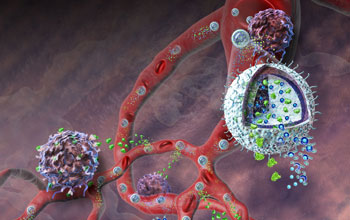 |
|
Illustration depicts the nanolipogel, developed at Yale University with NSF support, administering its immunotherapy cargo. Courtesy of Nicolle Rager Fuller, NSF |
In theory, the body's immune system can target and fight cancer, but in practice the tumors are rather good at trashing these attempts. Cancer immunotherapies can try to boost the body's fighting forces, and drugs can neutralize the cancer's defenses, but the cancer can find ways to thwart these, too. Tiny particles of gel, reported in a study in Nature Materials, seem to get around this by delivering both approaches at the same time, right to where they are needed.
The technique of both boosting the immune response and neutralizing the tumor's attempts to damp down the immune system hasn't always seemed to work in the past. A team from Yale University may have turned this around--the researchers have combined an immune system booster (interleukin-2; IL-2) and a drug that inhibits transforming growth factor-β (TGF-β), one of the cancer's defenses, in nanolipogels (hollow biodegradable spheres). Interleukin 2 is a large protein that is soluble in water, and the TGF-β inhibitor repels water and is very small, and the gels have been designed to accommodate both--the shell includes the TGF-β inhibitor, and this is wrapped around and traps a solution of the protein.
"You can think of the tumor and its microenvironment as a castle and a moat," says Tarek Fahmy of Yale University. "The 'castles' are cancerous tumors, which have evolved a highly intelligent structure--the tumor cells and vasculature. The 'moat' is the cancer's defense system, which includes TGF-β. Our strategy is to 'dry-up' that moat by neutralizing the TGF-β. We do that using the inhibitor that is released from the nanolipogels. The inhibitor effectively stops the tumor's ability to stunt an immune response."
When the nanolipogels were given to mice, they got trapped in the blood vessels around the tumors and released their contents gradually. The gels triggered an immune response, and the mice's tumor growth slowed and even went into remission, and they lived longer.
The advantage of using the gel drug delivery system is that it delivers both drugs to the tumor where they are needed, at the same time, and could reduce the amount of drug that reaches the rest of the body, so cutting the amount of drug needed, and reducing side effects. The researchers used mouse models of melanoma (skin cancer), including disease that had spread to the lungs. This is a cancer that is hard to treat with radiation, chemotherapy and surgery; however, the gels could also have potential in other cancers where two dissimilar molecules need to be delivered at the same time.
- read the press release
- see the abstract